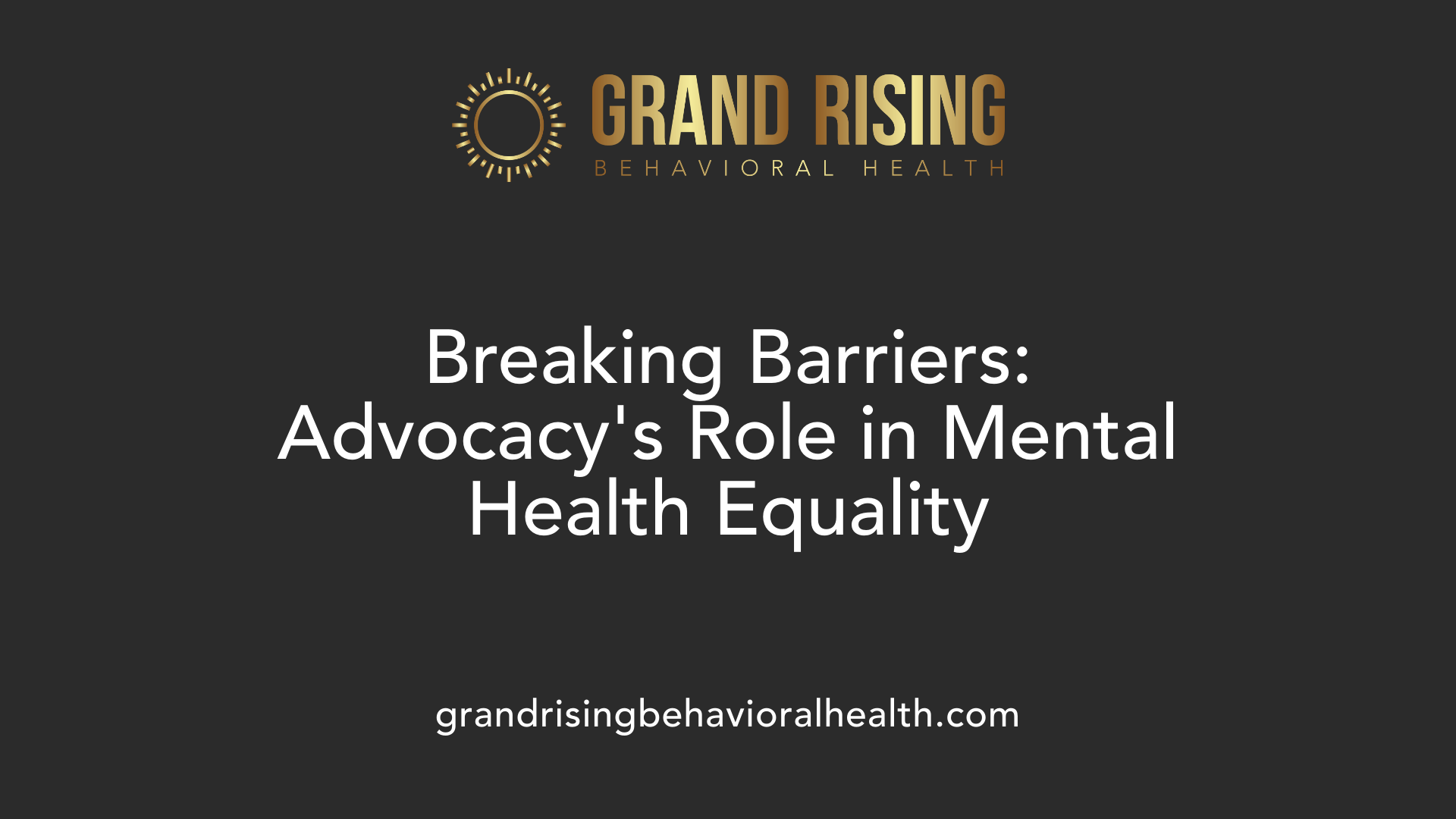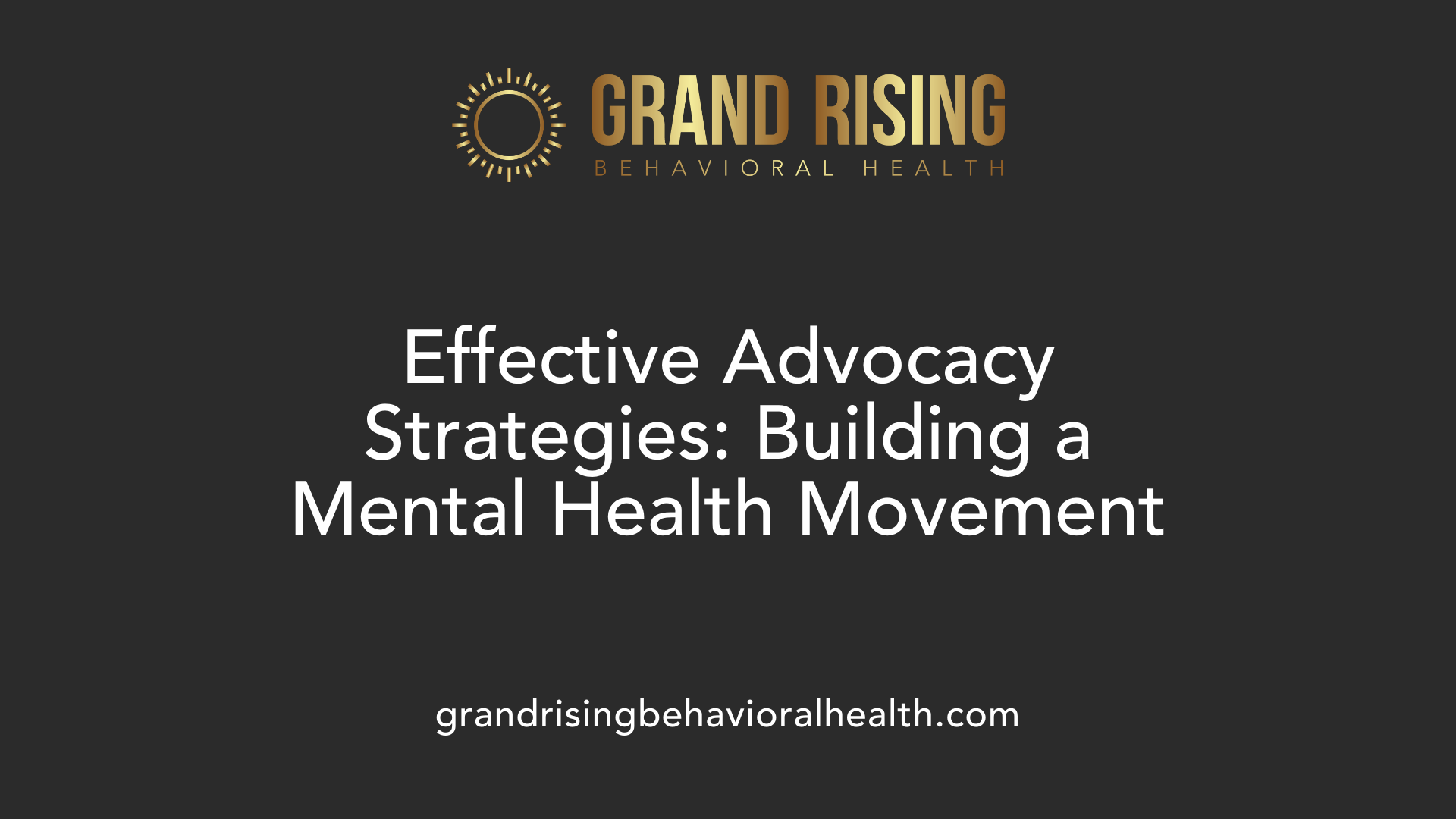The Importance of Advocacy in Behavioral Health Awareness
Empowering Change Through Mental Health Advocacy

Advocacy as a Catalyst for Behavioral Health Progress
Advocacy plays a fundamental role in shaping the landscape of behavioral health, acting as a catalyst for societal change, policy reform, and the reduction of stigma surrounding mental health issues. By mobilizing communities, influencing legislation, and raising public awareness, advocacy efforts improve access to vital services, promote early intervention, and uphold the rights of individuals with mental health conditions. This article explores the significance of advocacy in fostering a healthier, more inclusive society, emphasizing strategies, principles, real-life examples, and the collaborative efforts that drive meaningful change.
Understanding the Critical Role of Advocacy in Behavioral Health

Why is mental health advocacy important?
Mental health advocacy is essential because it tackles the stigma and discrimination that often prevent individuals from seeking necessary care. By raising awareness and educating the public, advocacy helps promote early diagnosis and effective treatment, ultimately improving mental health outcomes. It also plays a critical role in protecting the human rights of those with mental health conditions, ensuring they receive equal support and resources. Societal understanding and compassion are deepened through advocacy efforts, which help reduce cultural barriers, funding shortages, and workforce challenges. In the end, advocacy contributes to building healthier communities by supporting prevention, resilience, and equitable access to mental health services.
What is the impact of advocacy on reducing stigma and increasing access to services?
Advocacy significantly influences the reduction of stigma surrounding mental illness. Campaigns such as 'Make It OK' and initiatives focusing on PTSD among veterans have demonstrated how public education and personal stories can change perceptions. These efforts foster empathy and normalize conversations about mental health, encouraging more individuals to seek help early. Additionally, advocacy expands access to services by lobbying for policy reforms, increasing funding, and improving insurance coverage through mental health parity laws. Organizations like NAMI, Mental Health America, and Active Minds actively work to create a more inclusive mental health system, ensuring that support reaches underserved communities and vulnerable populations.
How does advocacy protect the human rights of individuals with mental health conditions?
Advocacy promotes the human rights of individuals with mental health issues by fighting against harmful practices, advocating for policy reforms, and ensuring fair treatment within healthcare and legal systems. It seeks to eliminate structural and societal barriers that hinder access to care and perpetuate discrimination. Organizations like the National Alliance on Mental Illness (NAMI) and Mental Health America support policy changes that enhance crisis intervention, uphold dignity, and foster community inclusion. Personal stories shared through advocacy empower individuals, giving them a platform to influence policies that impact their lives. Such concerted efforts move society toward embracing mental health as a fundamental human right, fostering an environment of respect, support, and justice.
Strategies and Methods for Effective Mental Health Advocacy

What are some effective strategies and methods for mental health advocacy?
Effective mental health advocacy employs a variety of approaches aimed at education, awareness, and systemic change. Key strategies include launching public awareness campaigns that dispel myths, normalize conversations, and foster understanding. Campaigns like Mental Health Month and organizations such as Active Minds use multimedia content—videos, social media posts, blogs—to reach diverse audiences.
Advocates also focus on supporting legislation that enhances mental health rights. This involves lobbying policymakers, promoting parity laws that improve insurance coverage for mental health services, and championing early intervention programs.
Building collaborations between healthcare providers, community groups, and government agencies amplifies impact. These coalitions work on shared goals such as expanding access, reducing stigma, and integrating mental health care into primary care settings.
To combat barriers like societal discrimination and resource shortages, coordinated community efforts and sustained awareness initiatives are vital. This multifaceted approach ensures that advocacy reaches all societal levels—local, regional, and national—creating an environment conducive to mental health support.
What are some concrete steps to becoming an effective mental health advocate?
Starting as a mental health advocate involves education—learning about mental illnesses, treatment options, and how to communicate about mental health effectively. From there, individuals can participate in community events, support groups, and awareness campaigns to help normalize discussions.
Joining organizations such as NAMI or Mental Health America provides resources, training, and opportunities for advocacy. Engaging online through social media allows advocates to reach broader audiences, challenge stigmatizing language, and promote mental health literacy.
Supporting policy initiatives is another critical step. Contacting legislators, attending town halls, and participating in advocacy days help influence policy decisions. Collaborating with local leaders and community organizations further amplifies efforts.
Setting specific, achievable goals—such as organizing local awareness events or advocating for legislation—keeps efforts focused. These steps help individuals to make tangible contributions toward improving mental health awareness and systemic support.
How can digital platforms enhance mental health advocacy?
Digital platforms offer unparalleled opportunities for wide-reaching impact. Social media campaigns and dedicated websites enable advocates to share personal stories, factual information, and resources instantly and globally.
Apps and online forums facilitate peer support, providing safe spaces for individuals to connect and share experiences, which helps reduce feelings of isolation.
Campaigns that incorporate videos, interactive content, and celebrity endorsements tend to attract larger audiences, thereby normalizing mental health conversations. For example, initiatives run by organizations like CIMH and Active Minds have successfully used multimedia to reach youth and communities.
Digital outreach also promotes early help-seeking by making information accessible 24/7. The ability to track engagement metrics allows advocates to tailor messages effectively, ensuring messaging resonates and motivates action.
What steps can individuals take to become effective mental health advocates?
Anyone interested in advocacy should start by educating themselves about mental health issues, treatments, and available resources. This foundational knowledge enables confident and informed conversations.
Actively participating in local awareness events, volunteering, and sharing personal or community stories serve to humanize mental health challenges and combat stigma.
Connecting with advocacy organizations provides guidance, training, and opportunities for engagement. Using social media to spread information and challenge stigma also plays a vital role.
Building relationships with community leaders, policymakers, and healthcare providers can lead to meaningful influence. Setting measurable goals, like organizing a support event or contacting legislative representatives, helps maintain momentum and focus efforts.
How do public awareness campaigns and education efforts support mental health advocacy?
Campaigns like Mental Health Awareness Month serve as focal points for mobilizing communities, schools, workplaces, and media to discuss mental health openly. These campaigns increase literacy, normalize seeking help, and challenge negative stereotypes.
Educational initiatives in schools and workplaces further embed mental health into daily conversations, encouraging early recognition and intervention.
Media coverage, celebrity involvement, and interactive content create a broader cultural shift, fostering empathy and dismantling stigma.
By demonstrating societal support through data, personal stories, and advocacy events, these campaigns influence policy priorities and funding allocations, leading to more comprehensive mental health services.
What are effective ways to build support networks and coalitions for mental health advocacy?
Building robust support networks involves partnering with a diverse array of stakeholders, including healthcare professionals, community organizations, schools, and workplace leaders.
Establishing advocacy groups, informal support circles, and coalitions helps unify voices and coordinate efforts. Leveraging social media, newsletters, and workshops boosts visibility and engagement.
Regular communication, transparent leadership, and clear shared goals enhance group cohesion. Including affected individuals ensures relevant and responsive advocacy.
These networks work together to push for policy reforms, increased funding, and community-based programs that support mental health at local and national levels.
What is the role of storytelling and personal narratives in mental health advocacy?
Stories of personal experience are tremendously impactful; they humanize the abstract concept of mental health challenges, foster empathy, and build community.
Sharing recovery stories demonstrates resilience and hope, inspiring others to seek help and reducing feelings of shame.
Personal narratives are especially effective in campaigns, policy discussions, and community events as they evoke emotional responses and make issues tangible.
Leveraging these stories can influence policymakers and stakeholders by illustrating real-world impacts, underscoring the urgency for systemic change.
| Strategy/Method | Description | Impact | Examples |
|---|---|---|---|
| Public Awareness Campaigns | Initiatives like Mental Health Month, multimedia outreach | Increase literacy, normalize discussions | Each Mind Matters, #MentalHealthAwareness |
| Legislative Lobbying | Working with lawmakers to pass supportive laws | Policy change, increased resources | Mental health parity laws, Medicaid funding |
| Building Support Networks | Collaborating with organizations and communities | Amplify advocacy, influence policy | Local support groups, coalitions |
| Digital Platforms | Using social media, apps, online forums | Broaden reach, foster peer support | Active Minds campaigns, online support groups |
| Personal Stories and Community Engagement | Sharing lived experiences | Reduce stigma, inspire others | Media stories, advocacy blogs |
Through these combined efforts, mental health advocacy continues to evolve as a vital force for societal change, ensuring that support, understanding, and resources are accessible to all.
Addressing Systemic Barriers and Promoting Policy Change

How does advocacy influence mental health policies and legislative changes?
Advocacy significantly impacts the development and implementation of mental health policies and laws. By raising public awareness, reducing stigma, and rallying community support, advocates motivate policymakers to prioritize mental health issues. They engage in lobbying, share compelling personal stories, and build networks that support legislative goals. Organizations such as NAMI, Mental Health America (MHA), and the American Foundation for Suicide Prevention (AFSP) operate at local, state, and federal levels to push for policies that expand insurance coverage, fund community mental health centers, and integrate mental health services into primary care settings. These efforts often lead to crucial reforms like mental health parity laws, which mandate insurance companies to provide comparable coverage for mental and physical health conditions. Sustained advocacy ensures mental health remains a legislative priority, influencing laws that remove barriers such as coverage limitations, provider shortages, and inadequate crisis response systems. Overall, advocacy is vital for translating awareness into tangible policy changes that improve access and quality of mental health care.
What are some successful examples of policy reforms driven by advocacy efforts?
Advocacy has led to several notable policy achievements. One prominent example is the enactment of mental health parity laws, which enforce equal coverage for mental health treatments under insurance policies. Grassroots campaigns and legislative lobbying have also increased funding for mental health services, expanded telehealth options, and promoted integrated care models. Organizations like NAMI have influenced laws that expand crisis intervention strategies, improve detox and inpatient services, and safeguard human rights for individuals with mental health conditions. In addition, advocacy efforts have pushed for culturally responsive services tailored to marginalized communities, addressing disparities in access. Examples include policy reforms that facilitate law enforcement training on mental health crises, improve emergency response protocols, and promote community-based recovery programs. These reforms demonstrate how persistent advocacy efforts can create systemic change, making mental health support more equitable, accessible, and effective.
How do advocacy efforts address disparities in access to mental health care?
Disparities in mental health access stem from economic, cultural, and geographic barriers. Advocacy organizations work to identify and dismantle these obstacles by promoting policies that allocate resources to underserved populations and culturally competent services. This includes funding community outreach programs, expanding telehealth to reach rural areas, and advocating for insurance reforms that eliminate prior authorization and low reimbursement rates. Efforts also focus on integrating mental health services into settings familiar to traditionally marginalized groups, such as schools and religious institutions. Raising awareness about social determinants of health helps inform policies that foster equitable access, ensuring services are culturally sensitive, linguistically appropriate, and available regardless of socioeconomic status. By influencing legislation and public opinion, advocacy helps create a more inclusive mental health system where disparities are reduced, and everyone receives the care they need.
What role does community engagement play in fostering systemic change?
Community involvement is central to effective mental health reform. Engaged communities—comprising individuals with lived experience, families, local organizations, and healthcare providers—collaborate to identify specific needs, barriers, and culturally relevant solutions. Community participation builds trust, enhances the relevance of programs, and fosters ownership of mental health initiatives. Grassroots support amplifies advocacy efforts by demonstrating widespread engagement, persuading policymakers to commit resources and enact reforms. Inclusive community engagement ensures that services are tailored, sustainable, and equitable, ultimately driving systemic change that resonates with local realities and promotes long-term mental health improvements.
How has advocacy contributed to the shift toward community-based and culturally responsive mental health services?
Advocacy has been pivotal in moving mental health care from institutional settings to community-based models. Campaigns and policy proposals emphasize funding for local programs integrated within schools, faith organizations, and primary healthcare. These community-focused initiatives provide treatment in familiar, accessible environments, reducing stigma and barriers to help-seeking. Advocates highlight disparities faced by racial, ethnic, and marginalized groups and push for reforms that embed cultural competence into mental health services. This includes recruiting diverse providers, translating materials, and designing programs that address specific social determinants. The result is more inclusive, respectful, and effective care that encourages engagement, supports recovery, and fosters trust within diverse communities. This paradigm shift ensures mental health services are not only accessible but also culturally responsive and attuned to the needs of all populations.
Building a More Inclusive Future
In conclusion, advocacy in behavioral health is more than just raising awareness; it is a vital driver of systemic change, policy reform, and societal transformation. Through dedicated efforts—ranging from education campaigns and personal storytelling to legislative lobbying and community engagement—advocates create a foundation for a more inclusive, equitable, and compassionate mental health landscape. Addressing barriers, reducing stigma, and safeguarding rights are ongoing challenges that demand collaborative action and unwavering commitment. By supporting and amplifying advocacy initiatives at all levels—local, state, and national—stakeholders can ensure that mental health becomes a priority for everyone, fostering resilient communities and empowering individuals to thrive. The collective power of advocacy promises a future where mental health support is accessible, respectful, and integrated into the fabric of society, ultimately promoting healthier lives and a more empathetic world.
References
- Mental Health Advocacy and Its Importance in Public Health
- Mental Health Awareness: Breaking the Stigma - Park University
- Advocating for Mental Health: Your Voice Matters | La Amistad
- Why Mental Health Advocacy is Important | The Phoenix RC
- Advocacy - National Alliance on Mental Illness (NAMI)
- The Importance of Mental Health Advocacy in Modern Society
- Mental health awareness: uniting advocacy and research - Nature
- Honoring Mental Health Awareness Month through Public Advocacy
- Behavioral Health Advocacy: Voices for Change
More Resources
A team ready to start your journey.
Get in touch — today.
We are a safe space – a haven for exceptional individuals to receive discreet, personalized, in-person treatment and care.
.avif)










